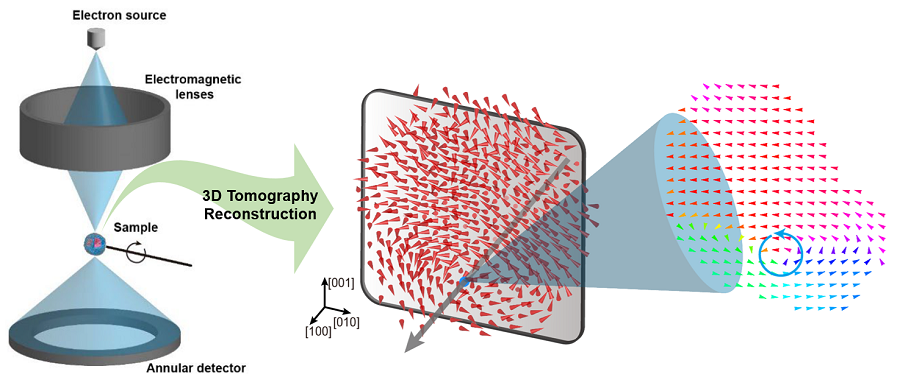Reviewed by Lexie CornerJun 3 2024
The research team from the Department of Physics at KAIST (led by Dr. Yongsoo Yang) has collaborated with POSTECH, SNU, KBSI, LBNL, and the University of Arkansas to experimentally clarify the three-dimensional, vortex-shaped polarization distribution inside ferroelectric nanoparticles. This research was published in Nature Communications.
 Three-dimensional polarization distribution of BaTiO3 nanoparticles revealed by atomic electron tomography. (Left) Schematic of the electron tomography technique, which involves acquiring transmission electron microscope images at multiple tilt angles and reconstructing them into 3D atomic structures. (Center) Experimentally determined three-dimensional polarization distribution inside a BaTiO3 nanoparticle via atomic electron tomography. A vortex-like structure is clearly visible near the bottom (blue dot). (Right) A two-dimensional cross-section of the polarization distribution, thinly sliced at the center of the vortex, with the color and arrows together indicating the direction of the polarization. A distinct vortex structure can be observed. Image Credit: Korea Advanced Institute of Science & Technology
Three-dimensional polarization distribution of BaTiO3 nanoparticles revealed by atomic electron tomography. (Left) Schematic of the electron tomography technique, which involves acquiring transmission electron microscope images at multiple tilt angles and reconstructing them into 3D atomic structures. (Center) Experimentally determined three-dimensional polarization distribution inside a BaTiO3 nanoparticle via atomic electron tomography. A vortex-like structure is clearly visible near the bottom (blue dot). (Right) A two-dimensional cross-section of the polarization distribution, thinly sliced at the center of the vortex, with the color and arrows together indicating the direction of the polarization. A distinct vortex structure can be observed. Image Credit: Korea Advanced Institute of Science & Technology
Ferromagnets are materials that can maintain a magnetized state without an external magnetic field (that is, permanent magnets). As they retain a polarized state without an external electrical field, ferroelectrics are regarded as the electric counterpart to ferromagnets.
Ferromagnets lose their magnetic properties when reduced to nano sizes below a certain threshold. For a long time, there has been debate over what occurs when ferroelectrics are similarly made exceedingly small in all dimensions (that is, into a zero-dimensional structure like nanoparticles).
Approximately 20 years ago, Prof. Laurent Bellaiche (now at the University of Arkansas) and his associates theoretically predicted that a special type of polarization distribution, structured like a toroidal vortex, could exist inside ferroelectric nanodots.
They also proposed using this vortex distribution to create ultra-high-density memory devices with capacities more than 10,000 times larger than current ones, provided that it could be managed appropriately. However, the challenge of quantifying the three-dimensional polarization distribution inside ferroelectric nanostructures has prevented experimental elucidation.
The KAIST research team successfully resolved this 20-year problem using an approach known as atomic electron tomography. This method involves taking images of the nanomaterials from various tilt angles using an atomic-resolution transmission electron microscope and then utilizing sophisticated reconstruction techniques to transform the images back into three-dimensional structures.
Electron tomography is essentially the same process as a CT scan, which is used in hospitals to inspect internal organs in three dimensions. The KAIST researchers modified this process specifically for nanomaterials by using an electron microscope to examine them at the single-atom level.
Using atomic electron tomography, the researchers accurately determined the locations of cation atoms inside barium titanate (BaTiO3) nanoparticles, an established ferroelectric material, in three dimensions. Using the accurately calculated 3D atomic configurations, they were able to derive the internal three-dimensional polarization distribution at the single-atom level.
For the first time experimentally, the investigation of the polarization distribution revealed that topological polarization orderings such as vortices, anti-vortices, skyrmions, and a Bloch point exist inside 0-dimensional ferroelectrics, as predicted theoretically two decades ago. It was also discovered that the number of internal vortices can be adjusted based on size.
Prof. Sergey Prosandeev and Prof. Bellaiche (who, with other coworkers, established the polar vortex ordering theoretically 20 years ago) joined this partnership and demonstrated that experimental vortex distribution results are compatible with theoretical predictions.
Controlling the quantity and direction of these polarization distributions is projected to enable the development of next-generation high-density memory devices capable of storing more than 10,000 times the amount of information in the same-sized device as those currently available.
Dr. Yang, who conducted the study, emphasized the importance of the findings.
This result suggests that controlling the size and shape of ferroelectrics alone, without needing to tune the substrate or surrounding environmental effects such as epitaxial strain, can manipulate ferroelectric vortices or other topological orderings at the nano-scale. Further research could then be applied to the development of next-generation ultra-high-density memory.
Dr. Yongsoo Yang, Study Corresponding Author and Professor, Department of Physics, Korea Advanced Institute of Science and Technology
This study, with Chaehwa Jeong from the Department of Physics at KAIST as the first author, was published online in Nature Communications.
The study was primarily supported by National Research Foundation of Korea (NRF) Grants provided by the Korean government (MSIT).
Journal Reference:
Jeong, C., et al. (2024) Revealing the three-dimensional arrangement of polar topology in nanoparticles. Nature Communications. doi:10.1038/s41467-024-48082-x